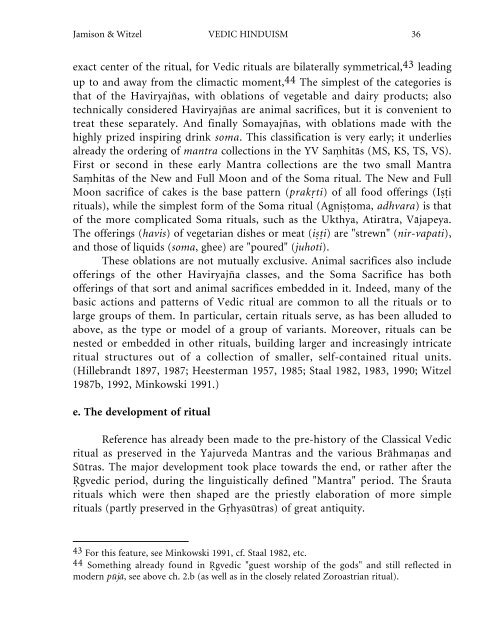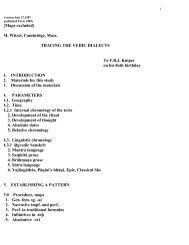VEDIC HINDUISM by S. W. Jamison and M. Witzel - people.fas ...
VEDIC HINDUISM by S. W. Jamison and M. Witzel - people.fas ...
VEDIC HINDUISM by S. W. Jamison and M. Witzel - people.fas ...
Create successful ePaper yourself
Turn your PDF publications into a flip-book with our unique Google optimized e-Paper software.
<strong>Jamison</strong> & <strong>Witzel</strong> <strong>VEDIC</strong> <strong>HINDUISM</strong> 36<br />
exact center of the ritual, for Vedic rituals are bilaterally symmetrical,43 leading<br />
up to <strong>and</strong> away from the climactic moment,44 The simplest of the categories is<br />
that of the Haviryajñas, with oblations of vegetable <strong>and</strong> dairy products; also<br />
technically considered Haviryajñas are animal sacrifices, but it is convenient to<br />
treat these separately. And finally Somayajñas, with oblations made with the<br />
highly prized inspiring drink soma. This classification is very early; it underlies<br />
already the ordering of mantra collections in the YV Sa�hitås (MS, KS, TS, VS).<br />
First or second in these early Mantra collections are the two small Mantra<br />
Sa�hitås of the New <strong>and</strong> Full Moon <strong>and</strong> of the Soma ritual. The New <strong>and</strong> Full<br />
Moon sacrifice of cakes is the base pattern (prak�ti) of all food offerings (I��i<br />
rituals), while the simplest form of the Soma ritual (Agni��oma, adhvara) is that<br />
of the more complicated Soma rituals, such as the Ukthya, Atiråtra, Våjapeya.<br />
The offerings (havis) of vegetarian dishes or meat (i��i) are "strewn" (nir-vapati),<br />
<strong>and</strong> those of liquids (soma, ghee) are "poured" (juhoti).<br />
These oblations are not mutually exclusive. Animal sacrifices also include<br />
offerings of the other Haviryajña classes, <strong>and</strong> the Soma Sacrifice has both<br />
offerings of that sort <strong>and</strong> animal sacrifices embedded in it. Indeed, many of the<br />
basic actions <strong>and</strong> patterns of Vedic ritual are common to all the rituals or to<br />
large groups of them. In particular, certain rituals serve, as has been alluded to<br />
above, as the type or model of a group of variants. Moreover, rituals can be<br />
nested or embedded in other rituals, building larger <strong>and</strong> increasingly intricate<br />
ritual structures out of a collection of smaller, self-contained ritual units.<br />
(Hillebr<strong>and</strong>t 1897, 1987; Heesterman 1957, 1985; Staal 1982, 1983, 1990; <strong>Witzel</strong><br />
1987b, 1992, Minkowski 1991.)<br />
e. The development of ritual<br />
Reference has already been made to the pre-history of the Classical Vedic<br />
ritual as preserved in the Yajurveda Mantras <strong>and</strong> the various Bråhma�as <strong>and</strong><br />
Sūtras. The major development took place towards the end, or rather after the<br />
�gvedic period, during the linguistically defined "Mantra" period. The Śrauta<br />
rituals which were then shaped are the priestly elaboration of more simple<br />
rituals (partly preserved in the G�hyasūtras) of great antiquity.<br />
43 For this feature, see Minkowski 1991, cf. Staal 1982, etc.<br />
44 Something already found in �gvedic "guest worship of the gods" <strong>and</strong> still reflected in<br />
modern pūjå, see above ch. 2.b (as well as in the closely related Zoroastrian ritual).

















